Farnborough
Germanus holds from the Bishop 8 hides of this land in ITCHEL
and COVE -- Domesday Book, 1086
There is a green hill far away -- reference in a hymn to the
green fern hill on which sits the Farnborough Parish Church of St Peter
Farnborough derives its name from from the
Anglo-Saxon settlement of Ferneberga (Fern Hill) and
is mentioned in the Domesday Book (1086). But for the coming of the
army at nearby Aldershot, the arrival of the railways, and the beginning
of flying, Farnborough would probably have remained an isolated heathland
village, that is until the latter half of the 20th century when the
population moved out of London suburbia and became commuters.
The Parish of Farnborough, and the nearby village of Cove (Parish of
Yately), were part of the Saxon Hundred of Crondal - Farnborough,
Yately, Aldershot, Crondal, Long Sutton.
Modern-day Farnborough is a dormitory town, with sad-faced
commuters enduring the daily trek into London on overcrowded,
overpriced, unreliable trains. Recently there has been
substantial inward investment, with a significant number of
people now commuting into Farnborough.
Farnborough is located in north-east Hampshire on the
Surrey-Hampshire border, approximately 50 km
south-west of London in southern England. Farnborough lies at
the centre of a ribbon of urban development. Starting in the
north with Camberley and Frimley over the border into Surrey and
then ending in the south with Aldershot
and back over the border into Surrey with Farnham.
Farnborough has no heart. What passes as the town centre is a
parade of modern shops flanked on either side by two of the
country's ugliest shopping centres. Their royal names do little
to hide their general shabbiness. Many of the shops are boarded-up
and empty. Few of those trading are worth a visit (though
there are exceptions), many are only waiting for their lease to
expire before they too close down. Too many have been forced out
by extortionate rents and poor service. Recently one of the shopping
centres has been sold.
The town centre is currently undergoing what is jokingly called
redevelopment, revitalisation of the town centre, but what in
reality is town centre destruction, with
many of the retailers being driven out of town.
For serious shopping the local residents
travel to Camberly, Guildford,
Farnham, Reading or London. At
night the town centre is dead. A front page report in the local
Farnborough News described the town centre as doomed
(Farnborough News, Friday 19 December 1997). More recent newspaper
reports have followed a similar theme as the local community and
retailers get ever more disillusioned at what they see as wanton
destruction of their town centre.
No one would regard the centre of Farnborough as attractive,
therefore the plans by the new Arab owners (Kuwaiti-funded KPI,
a St Modwen front company) to demolish has met
with mixed reception. What has angered many people, especially
the few local traders who are trying hard to make a living, was
to wake up one morning to discover their businesses
and homes were destined to be reduced to a pile of rubble. Proposals
were drawn up in
consultation with the local authority without any consultation with
the traders or the public. It seems Arabs who don't even know
where Farnborough is let alone how to pronounce it have a greater
say in the future of Farnborough than the people who live and work
there. This is but one of many examples of Rushmoor
conspiring with Big Business to the detriment of the local community.
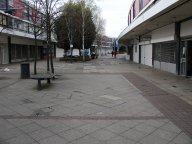 The new owners, whether intentionally or not, have systematically laid waste to the town centre. As a result the town centre consists of little more than boarded-up shops, litter, charity shops, junk food shops, and too few people on the streets. All the classic signs of a failing town centre. Those who have the means shop elsewhere. The few remaining retailers are struggling to make ends meet.
The new owners, whether intentionally or not, have systematically laid waste to the town centre. As a result the town centre consists of little more than boarded-up shops, litter, charity shops, junk food shops, and too few people on the streets. All the classic signs of a failing town centre. Those who have the means shop elsewhere. The few remaining retailers are struggling to make ends meet.
Were the developers to get their way, they would demolish the entire northern half of the town centre and replace with a superstore, social housing to be demolished for a car park for the superstore. Were the plans to go ahead, it would destroy what little is left of the town centre. Not surprisingly, the plans have met with strong local opposition. The alternative, town centre regeneration, working from the bottom up with the local community, was never considered. [see Town centres – a tale of two councils]
The latest in this sorry saga, is that the plans have been referred by the Secretary of State to a public inquiry. The reaction of the Council, who to date have shown no interest in the fate of the town whatsoever, in particular the fate of struggling retailers, has been to threaten objectors with Asbos. Free speech apparently does not exist in the Stalinist State of the Rotten Borough of Rushmoor (as it is known locally).
[see Community activist threatened with an Asbo]
A Public Inquiry took place in the spring of 2006. Detailed scrutiny of the plans took place, the only occasion on which the plans had been scrutinised, but due to the very narrow remit of the Inquiry, only the road closures could be challenged, not the development itself. Some weeks later, in what was seen as a highly biased report, the Inspector having ignored everything the objectors had to say, the go-ahead was given for road closures to permit the unwanted scheme to go ahead. [see Farnborough town centre – highway closures]
Five years of false promises, duly regurgitated by a compliant local media as news, the threatened/promised demolition of the town centre finally got underway end of May 2007, almost ten years after the developers had bought the town centre. The demolition immediately ran into controversy as the site was only surrounded by a rickety six-foot fence giving little protection to the public. [see Town centre demolition danger]
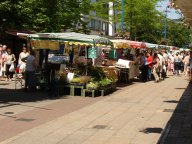 Many towns hold successful farmers markets, cf Farnham and Guildford, but not Farnborough. At first the local council, without any consultation with either the local community or retailers, promoted a disastrous French Market. It was not popular, and simply drained money out of the local economy. Eventually, after much pushing, the local council backed a farmers market, but even this they could not get right. It was Saturday mornings only, not, as in other towns, held on a regular basis. It was doomed from the start, and eventually failed.
Many towns hold successful farmers markets, cf Farnham and Guildford, but not Farnborough. At first the local council, without any consultation with either the local community or retailers, promoted a disastrous French Market. It was not popular, and simply drained money out of the local economy. Eventually, after much pushing, the local council backed a farmers market, but even this they could not get right. It was Saturday mornings only, not, as in other towns, held on a regular basis. It was doomed from the start, and eventually failed.
In 2006, an infrequent farmers market was resurrected, but it was a pathetic market, very few stalls, very little on offer. A far better farmers market is to be found in nearby Guildford (the first Tuesday of the month).
Farnborough has a weekly street market on a Tuesday in the car park outside Asda. It is a shadow of its former self. Yet another example of traders suffering in Farnborough due to the destruction of the town centre by greedy developers.
The only part of Farnborough with character is
North Camp, once
the original Victorian town centre and now looking rather dog-eared and run
down at the edges. The principle attraction of North Camp is
the large number of specialist shops and small businesses. After
years of decline and official neglect, North Camp is once again
starting to thrive. Pictures from a century ago show North Camp to be very busy.
The other distinct part of Farnborough is Cove. Once a small
village, long since engulfed by urban encroachment. Most of what
is now called Cove is one large housing estate of poor quality
housing. Cove was once the centre of a major pottery industry, as
late as the end of the 18th century there were known to be over a dozen
kilns in operation. The distinctive pottery known as Border Ware
was exported across Europe. The Manor House of Cove was
mentioned in the Domesday Book.
Once an independent borough, following local government
reorganisation in the mid-1970s, Farnborough together with
Aldershot now forms part of the
Borough of Rushmoor. The borough
is ruled by a council of 45 members elected from 15 wards.
The Old Town Hall, now private offices, lies half-way along
Alexandra Road, opposite St Mark's Church - the foundation stone
was laid in 1896. The style is Tudor-cum-1700, then the current
fashion. Farnborough Urban District Council was created
in 1894 by the Local Government Act (1894), before then the
affairs of the parish had been dealt with by the Vestry.
The Parish Vestry was the forum where church business and affairs
of the parish were discussed. Initially it dealt with church
business, appointment of Church Wardens, repairs to the fabric of
the building etc, increasingly it took on civil matters,
administration of the Poor Laws, upkeep of the highways, street
lighting, education etc. With the reform of local government in
1894, the role of the Vestry returned to church matters.
Farnborough is internationally known for its
airfield, site until
recently of the Royal Aircraft Establishment,
and for hosting the biennial
Farnborough International Airshow.
Plans to turn the airfield into the business airport for Europe have been
strongly
opposed by the local community. The local Council did as it usual does, ignored the wishes of the local community and granted planning permission for a business airport at Farnborough.
Farnborough Airport is operated by TAG Aviation. An
airport consultation committee is supposed to discuss issues affecting the local community, but as the community has only two seats, it has degenerated into a dysfunctional committee.
Having been granted planning consent to operate a business airport, TAG Aviation, like Oliver Twist, are now back for more. They wish to double their weekend movements, increasing the weekend limit from 2,500 to 5,000 movements per annum.
[see Weekend flights to double at Farnborough?]
In 1997 Farnborough once again made world headlines as the home of the record-breaking
ThrustSSC, holder of the world land speed record.
Many firsts are associated with Farnborough.
- In 1908, Samuel Cody become the
first man in England to fly a powered plane.
- Frank Whittle developed the world's first jet engine. The UK
become the first country to design, build and operate the world's
first commercial jet airliner.
- Much of the research for Concorde, until a major
disaster took concorde out of service, the world's
first and only supersonic airliner, took place in Farnborough.
- ThrustSSC was designed and developed in
Farnborough. In September 1997
ThrustSSC broke the world
land speed record with a speed of 714 mph. A few days later it became
the first powered land vehicle to break the sound barrier with a
speed of 763 mph Mach 1.02 - the supersonic bang reverberated
around the world. ThrustSSC is powered by two jet engines.
Opposite the RAE, or what was the RAE, lies
Farnborough College of Technology.
Originally founded and funded by the RAE to provide high quality
training for its apprentices and technical staff. [Critical comment on FCoT has
been removed because of threats by FCoT against the ISP]
Running parallel with the college on the north side lies Sycamore
Road. An unusual road as you only have to walk along it a short
distance away from the main road and it no longer feels like you
are in Farnborough. It feels like you are walking down a narrow country
lane. About a couple of hundred yards down the road is the former
residence of Percy Eastwood Fletcher, composer and conductor.
Percy Eastwood Fletcher (1879-1932), composer and conductor, was
born in Derby and died in Windsor. He was musical director of
several London theatres, including Drury Lane, Savoy and Prince
of Wales. He did much work with brass bands. He orchestrated
and arranged publication of works by Coleridge-Taylor. His own
works included Two Parisian Sketches (1914),
Rustic Revels (1918), Woodland Pictures (1920)
and Passion of Christ (1922).
For how long this part of Sycamore Road will remain a quiet country lane is a moot point. A further example of crass planning by the local Council, was the demolition of a large Victorian Mansion in this road to be replaced by a large block of flats. The house had extensive grounds, it could have been restored with internal conversion to flats. Imagination and forward planning is noticeably lacking in this council. Greed is the watchword. This development was strongly opposed by the local community, who see their local area being slowly destroyed by bad planning decisions and a council in the pocket of developers. The planning committee was told how to vote by the planning officials. [Farnborough Mail, Tuesday 27 July 2005]
Across the main road from the college lies
an expanding airport,
the college lies in the flight path. As a consequence the
college lies within the 1 in 1,000,000 societal risk contour, any
further expansion of flying will place the college
within the 1 in 100,000 individual risk
contour (a risk a local plan inquiry
inspector said should not extend over residential Farnborough,
let alone a college). The airport is to be used
for business aviation, executive jets have 15 times the crash
rate of scheduled commercial airlines. A local air safety expert
has issued dire warnings and will not let any of his family
attend the college as he believes the risk to be too great. The
nightmare scenario is a transatlantic jet, with a full load of
more than 35 tonnes of fuel on board, crashing on the college,
2-3,000 students incinerated. Apart from safety, students are
disrupted by the noise from low flying jets (the noise and
vibration sets off car alarms). [Farnborough News, Friday 12 November 1999]
The college has recognised that it could become a death trap and
fears plummeting student numbers will affect the commercial
viability of the college. A risk study by NATS has reinforced
the fears of the college and local residents. There is a
growing body of international evidence
that those working or studying near an airport suffer learning
and health problems from noise and air pollution and associated
stress levels. [Farnborough Mail, Tuesday 18 April 2000;
Farnborough News, 21 April 2000]
The alternative local choice for further education,
Farnborough Sixth Form College,
has been rated as one of the top two schools in the country for further education.
On the other side of the road from FCoT is the site of original
college. Formerly a convent, since vacated by the college it has
been refurbished and is now private offices. The attractive
Victorian building contrasts with the eyesore presented by the
ugly modern college buildings it now faces across the road. It
is difficult to decide which monstrosity should be awarded the
prize for the worst eyesore and lack of good taste - the present
college campus, the two-level car park a short way down the road,
or the multi-storey office blocks a little further down.
Hidden in the back streets of South Farnborough in Guildford Road
East is the quite remarkable Prince Regents Theatre.
Claimed to be the smallest working theatre in the country it is situated in
the founder's back garden. Described by Plays & Players
as 'a jewel in Farnborough'.
Also hidden in the back streets of South Farnborough, down Albert
Road, is an ancient tumulus. In the spring the Bronze Age Bowl Barrow
Burial Mound is carpeted with daffodils. The many splendid mature trees
in this area are under a death threat if the airport operators
have their way as they claim they are intruding into their airspace.
At the end of Guildford Road East lies Church Circle and the
infamous tree house, built by Ben Franklin for his young son.
Although causing no problems to anyone the local council decided
the tree house had to go. When Ben stood his ground, the local
council mounted a vicious, personal vendetta, with the intention
of destroying Ben and his family, as one official candidly put it
'we had to make an example of him'. Common sense finally
prevailed at an independent tribunal where a ruling was made
against the local council.
Whilst a cause célèbre the tree house is not an isolated
incident, it became a regular feature for Alan
Franklin (no relation of Ben Franklin), then editor of the
Surrey-Hants Star, to rail against the local
administration, which he refered to as 'Toy Town', for their crass
policies and planning decisions.
Close to the railway station and on top of a hill overlooking
Farnborough is situated
Saint Michael's Abbey.
Founded in 1883 by the Empress Eugenie and completed in 1888 the abbey
is a working abbey with a community of Benedictine Monks. Within the
abbey crypt are the tombs of Napoleon III and his wife Empress
Eugenie. Their son, Prince Imperial, is also entombed within the
abbey crypt. Occasional music recitals take place at the abbey.
Farnborough Abbey has recently republished a series of guides to
Farnborough and the surrounding area.
Also near to the railway station and sitting atop of a hill is the
Parish Church of Saint Peter.
Built in the Norman period (c 1200 AD), evidence of a church dating back to
Saxon times can be inferred from the circular plan of the
churchyard. To the side of the north doorway (Norman) are wall
paintings (c 1300 AD) of three female saints (St Eugenia, St Agnes
and St Mary Magdalene), only rediscovered during
renovation work in the middle of the 19th century and not fully
uncovered until 1986. The painting of St Eugenia is the only one known to
exist in England. Some of the external carved stonework indicates
that the church may have Celtic origins, this is reflected in the
Celtic symbolism of the recently commissioned (1996) church altar
cloth. Two interesting features of the church are the lych-gate (1907)
on the approach to the church and the 17th century gallery within
the church. The church has a lively congregation, with
Sunday evening worship usually augmented by a very talented group of musicians.
Good Friday 21 April 2000, St Peter's mounted an impressive production of
Stainer's The Crucifixion. Sir John Stainer (1840-1901) also
wrote songs of praise. Victorian music for amateurs, one either loves
it or hates it.
Behind the church lies St Peter's School - formerly
Farnborough Place, home for several centuries of
the Annesley family, Lords of the Manor. The Annesley family are
thought to have been the inspiration for Sir Walter Scott's novel
Guy Mannering. Later, Henry Wilmot owned Farnborough Place,
regular guests of the Wilmots included David Garrick, Hanna More
and Joshua Reynolds. Joshua Reynolds painted a portrait of Sarah
Wilmot, David Garrick wrote a memorial to Hoppy, the Wilmots'
cat. The house is built on brick-vault foundations. Some form
of manor house existed on the site as far back as Anglo-Saxon times.
To the north of Farnborough Abbey and occupying the highest point
with magnificent views of the surrounding countryside is the
convent school of
Farnborough Hill.
Originally a large manor
house built in 1860 for the publisher Thomas Longman and once the home of
Empress Eugenie it became a convent school in 1926. Charles Kingsley
(1819-1875), rector at the nearby village of Eversley and author of
The Water Babies, was a regular guest of Thomas Longman.
Farnborough Hill was the site of the first world championship
fight between the Irish-American John Heenan and the gypsy Tom Sayers
on 17 April 1860. A bare-knuckle fight, it went into 37 rounds
before the ropes were cut, the ring invaded, and the referee
abandoned the fight. The fight went on for a further 5 rounds, a
total of 2 hours 20 minutes, before being declared a draw. Both
contestants were awarded a championship belt. A crowd of 12,000
attended the illegal fight.
The actual site of the fights (the world championship was one of
many) was adjacent to the River Blackwater,
in a field behind the Ship Inn. The advantage of such a
location was that in the eventuality of the arrival of the
Hampshire Constabulary on the scene (prize fighting was illegal at
the time), the fighters could move across the river out of their
jurisdiction.
Apart from a book signing at the local library, no event took place in Farnborough to mark the 150th aniiversary of the fight. Not even at the Ship Inn, behind which the fight took place. [see First world championship fight John Heenan (USA) v Tom Sayers (UK)]
Further north, past Farnborough Hill, just off the main
Farnborough Road on Ship Lane, is the Ship Inn.
Several centuries old, the inn was originally known as the Royal
Ann, in honour of the longest ship in James II's navy. It changed
to the Royal George when a larger ship was launched in the reign
of George I, then changed its name again with the sinking off
Spithead of the warship HMS Royal George with loss of 800 men
including Admiral Kempenfelt.
Ship Inn is on the northern edge of an area known as
Farnborough Street which was the original
location of the village of Farnborough before the centre of
population shifted to North Camp
at the end of the 19th century with the coming of the army and
the railways. The village centre was at the crossroads formed by
Ship Lane and Highgate Lane. These two roads were the original
turnpike roads across the wastes of the surrounding heaths,
traditional haunts of highwaymen. At the village centre there
are a few interesting old houses, remnants of the original
village. The nearby Prince of Wales mentioned
in the Good Beer Guide has a good selection of real
ales.
The track running past Farnborough North Station, across
the line and across the River Blackwater, towards Frimley Green,
is the original track across the heathland. It crosses the
Blackwater Valley Trail, once a pleasant walk alongside the
river, now running parallel with a major road.
Almost opposite the Ship Inn, is another pub, The
George. Nothing special but it does serve as a local
community pub. It may soon be no more. In yet another example
of crass planning and greed the site of the pub is earmarked for
housing redevelopment. The plans are meeting strong opposition,
especially from the pub's regulars
Sadly The George is no more. Where it once stood is housing.
South of Farnborough Station, on the main Farnborough Road (A325),
lies the Tumbledown Dick public house. The name
is thought to be derived from Richard Cromwell, son of Oliver
Cromwell, who fell out of favour. The inn has associations with
the infamous highwayman Dick Turpin (1706-1739).
The most prominent landmark in Farnborough is the Clock House
(1895), just south of the railway station.
In the far north-west of Farnborough lies Hawley Wood
- an area of unspoilt semi-natural Scots Pine woodland and
heathland that opens out onto Hawley Common.
It has been designated a Site of Importance for Nature
Conservation (SINC) for its ecological value. Contrary to the
the Borough's own environmental policies and the site's
designated presumption against development there were plans to
develop 20% of the site for housing. These development plans
met with very strong local opposition.
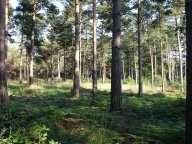
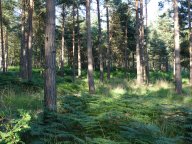
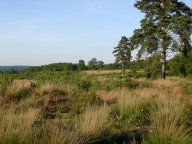
In an about turn, plans to develop Hawley Wood were dropped,
and the Local Plan modified. But this appears to be based on the
decision of the MoD not to put the land up for sale, rather than
any change of heart based upon the merits of the case, therefore
were the MoD to put the land back on the market conservationists
could once again find themselves manning the barricades.
[Farnborough News, Friday 24 July 1998]
Farnborough is surrounded by unspoilt heathland. The public is
free to roam apart from when the land is in use by the military.
Care should be taken not to stray off the tracks and into the
undergrowth or to touch any strange objects as there is always
the risk of danger from explosives.
The heathlands around Farnborough and Aldershot, in recognition of their international status, form part of the Thames Basin Heaths SPA. English Nature has designated an exclusion zone around the heathlands in which no development may take place to try to alleviate pressure on the fragile heathlands. The Rotten Borough of Rushmoor decided to stick two fingers up to nature conservation and gave the green light for development to go-ahead within the restricted zone. Greed rules OK! This puts Rushmoor on a direct collision course with the EU. [see Heathland under threat]
To the south of Farnborough lies the military town of
Aldershot. Beyond Aldershot, within the county
of Surrey, the small ancient town of Farnham.
Communications with Farnborough are good. M3 junction 4 and the
Blackwater Valley Relief Road (A331). Farnborough Station is on the main
line from London (Waterloo) with approximately four trains every
hour (fast, semi-fast and slow). There is also direct access to Gatwick Airport from
nearby North Camp Station (on the Reading-Guildford-Gatwick line). On the same line, Farnborough North
Station is ideal for Farnborough Street - the centre of the
original heathland village of Farnborough.
Goldline route 1 bus route runs through the Blackwater valley from Aldershot via Farnborough to Camberley.
A sign-posted cycle route runs from Farnborough to Aldershot. Given a free
choice, cyclists will always take the most direct route, running through
side streets to avoid the traffic. The sign-posted route takes a lengthy
detour to run alongside a busy main road!
Farnborough is
twinned
with the French town of
Meudon, the German town of Oberursel
and the Polish town of Sulechow.
A number of BookCrossing Zones are to be found in Farnborough. These are places where BookCrossing books are released into the wild.
Memorial to Hoppy, the Wilmots' cat (Farnborough Place)
Nine lives in sin and sorrow spent
Finish their course beneath this stone.
Here lies a wretch, on blood so bent
She, like Medea, spilt her own.
Death saw her deeds and jealous grew
To have a rival in his trade,
With envy saw the heaps she slew
And all the havoc she had made.
In rage the fatal dart he drives.
Not her nine lives his hunger pall.
Had Hoppy's every hair been lives,
Death had a stomach for 'em all.
-- David Garrick
Rushmoor Borough Council has published
a brief history of the area.
Farnborough Library houses a local collection. The
Aldershot Military Museum,
half-way between North Camp and Aldershot town centre, contains a
local history gallery. St Peter's Church has published an
excellent series of pamphlets illustrating the history of the
parish from the 17th to 19th century, plus a pamphlet on the church.
Jo Gosney has written Farnborough: A Pictorial History (Phillimore, 2005), a collection of annotated pictures of Farnborough over the last century. Looking at pictures of Farnborough of yesteryear one sees it has changed for the worse, and these changes are accelerating. Minor criticisms are the lack of an extensive bibliography and that some of the pictures are spread across the gutter of the book. Jo Gosney is also author of Farnborough Past.
Copies of Farnborough: A Pictorial History can be obtained from Book Boyz, one of the few remaining independent shops still left in Farnborough town centre. Book Boyz have a large selection of books on local history, and books not in stock can usually be obtained fairly quickly.
Directory ~
accommodation ~
bookshops ~
clothes ~
dry cleaners ~
environment ~
food & drink ~
property ~
taxis
Surrey-Hants ~
Airshow ~
North Camp ~
Aldershot ~
Farnham
(c) Keith Parkins 1997-2010
-- May 2010 rev 40
 The new owners, whether intentionally or not, have systematically laid waste to the town centre. As a result the town centre consists of little more than boarded-up shops, litter, charity shops, junk food shops, and too few people on the streets. All the classic signs of a failing town centre. Those who have the means shop elsewhere. The few remaining retailers are struggling to make ends meet.
The new owners, whether intentionally or not, have systematically laid waste to the town centre. As a result the town centre consists of little more than boarded-up shops, litter, charity shops, junk food shops, and too few people on the streets. All the classic signs of a failing town centre. Those who have the means shop elsewhere. The few remaining retailers are struggling to make ends meet.



